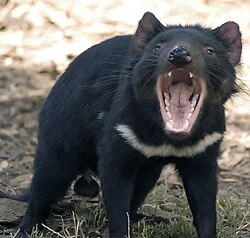Official symbols
| Symbol | Name | Image | Adopted | Remarks |
|---|---|---|---|---|
| State Flag | Flag of Tasmania |  | 3 December 1975 | It was approved by the British Colonial Office on 29 November 1875 |
| State Badge | State Badge of Tasmania |  | 29 November 1875 | |
| State Coat of arms | Coat of arms of Tasmania |  | 7 March 1919 | The Coat of arms of Tasmania is an official symbol of the state, granted by King George V on 29 May 1917. The shield features significant representations of Tasmanian industry, including a sheaf of wheat, hops, a ram, and Tasmanian apples on a branch. |
| State Motto | Ubertas et fidelitas Fertility and Faithfulness | 7 March 1919 | Granted with other elements of the coat of arms | |
| State Flower Emblem | Tasmanian blue gum Eucalyptus globulus |  | 5 December 1962 | |
| State Animal Emblem | Tasmanian devil Sarcophilus harrisii |  | 22 May 2015 | |
| State Mineral Emblem | Crocoite |  | 6 December 2000 | |
| State tartan | Tasmanian tartan |  | 1999 | Recorded prior to the launch of the Scottish Register of Tartans (SRT) in 2009, [1] [2] and also registered in the SRT as a district tartan. [1] Although it is not included in the lists of State emblems and symbols published by the legislative and executive arms of the government of Tasmania, [3] [4] its entry in the SRT, and the corresponding web page of the Scottish Tartans Authority website, both assert that it was recognised in 1999 as the official State tartan. [1] [2] |
| State government logo | Tasmanian Government Logo | |||